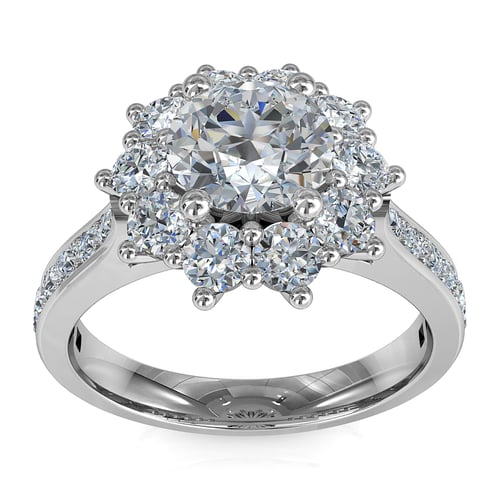|
TL;DR Engagement ring settings include styles like solitaire, halo, pavé, bezel, channel, and tension. Each offers different levels of sparkle, security, and maintenance. Solitaires highlight the centre stone, while bezel and channel settings provide added protection. Pavé and halo designs maximise brilliance but may require more upkeep. Choosing the right setting depends on lifestyle, design preferences, and how much wear the ring will experience. |
Before you overwhelm yourself by walking into a jewellery store with no idea what kind of engagement ring you’re seeking, familiarise yourself with standard settings. Although trends come and go, engagement rings nearly always fall into one of the setting categories we’ll look at in this article.
It’s not necessary to know precisely what you’re looking for when you shop, but if you narrow your preferences down to two or three different settings, you’ll have a much easier time. Keep in mind that some settings are higher maintenance than others. Also, brides with active lifestyles may gravitate towards lower-profile settings.
What’s the perfect setting for you? Only you can decide. With so many gorgeous settings out there, narrowing them down is not easy!

Solitaire
A solitaire setting is a perfect “safe” choice for someone who only knows their partner’s stone shape preferences. Classic and timeless, a solitaire setting consists of a single band with a single stone. Because of its simplicity, it can be paired with many wedding band styles, adding personality and sparkle.
On the downsides, solitaires can easily snag on clothing and other items. It may not be the best choice for people who work with tools or enjoy rock climbing. If you choose a solitaire but worry about the diamond’s safety, look for a setting with six prongs instead of four. The extra prongs offer extra protection to the edges of the diamond.
Pavé
Those who love sparkly engagement rings are often drawn to pavé settings. Pronounced, “pa-vay,” the name is derived from the French word “to pave.” In other words, this setting appears to be paved in diamonds.
Because the diamonds are held in place by mini-prongs that look like small beads, the overall appearance is continuous sparkle. The centre stone pops when placed in a pavé setting. Keep in mind that sizing and resizing can be tricky with pavé settings. Get the right size the first time, if humanly possible.
Channel-Set
The channel setting securely holds smaller diamonds in a channel in the ring's band. The row of sparkling diamonds is flush with the metal. Some channel settings span the ring's circumference while others extend part way around.
Channel settings are also popular for wedding bands and stackable rings. Since metal protects the diamonds on both sides, it’s very secure and unlikely to snag on clothing. One downside to this setting is that it can be challenging to keep clean. Dirt can become trapped in the channel. Also resizing can be difficult with a channel setting.
Side-Stone
Side-stone settings feature complementing diamonds or other gemstones, which soften the transition between the centre stone and the band.
You’ll find side-stone rings featuring trillions, baguettes, round brilliants, marquises, and any number of other diamond shapes. Side stones also allow you to add colour to an engagement ring in the form of emeralds, sapphires, rubies, opals or any of the birthstones.
Three-Stone
Three-stone settings carry beautiful symbolism with them. The three stones represent a couple’s past, present and future. Sometimes, the centre stone is larger than the two side-stones, and sometimes they’re all about the same size.
It’s possible to personalise a three-stone ring by using coloured gemstones on the sides; some people like to use birthstones. Be selective about the stones you choose for this setting. Sometimes the side stones overpower the centre stone.
Tension
Dramatic and brilliant, tension settings use the pressure of the band to hold the diamond in place. The stone appears to be suspended between the two sides of the shank. Because there’s minimal metal surrounding the diamond, this setting enhances light reflection. It’s perfect for a spectacular diamond.
Tension settings require very little maintenance, but they’re very difficult (sometimes impossible) to resize. In some cases, tension settings cause the diamond to appear smaller than it is. You can minimise this problem by choosing a thinner band.
Halo
The “halo” refers to the concentric circle or square around the centre stone, and it’s usually made of diamonds or other gemstones. Halo settings have been incredibly popular over the last five years. They increase the overall sparkle and size of the ring and securely hold the centre stone.
Halo settings are often paired with pavé bands (which we’ll cover below) because the levels of sparkle match so beautifully. A halo setting is best for someone who doesn’t work with their hands a lot; the side stones can loosen over time.
Bezel
Due to its modern styling and suitability for an active lifestyle, bezel settings have steadily been rising in popularity. Instead of prongs, a bezel setting surrounds the stone, holding it solidly in place and protecting it on all sides.
Bezel settings may be full or partial. Full bezels have a thin band of metal that completely surrounds the stone; partial bezels cup the stone only in certain places. It’s an excellent setting for teachers, nurses, artists and other people who worry about snagging their rings while they work. Realise, however, that bezel settings don’t offer the same light and brilliance as prong settings like solitaires.
Cathedral
The cathedral setting is one of the most elegant engagement rings styles on the market. It takes its name from the graceful arches of cathedral ceilings. The centre stone perches high above the band. It’s a great way to add drama and height without adding substantially to the cost.
A cathedral setting holds the stone securely, but it may interfere with some activities because of its height. It may also be more challenging to clean because the arches often have small crevices where dirt and dust can gather.
Vintage
Many vintage engagement ring settings hearken back to particular eras like Art Deco rings from the 1920s or Victorian styles from the 19th century. Vintage rings often feature detail work like filigree or milgrain.
Vintage settings radiate charm, and they’re usually intricately built and designed. You may need to clean it more frequently than you would a more straightforward ring.

Cluster Setting
This setting clusters many small stones together to create the impression of one large stone. Often, a larger stone sits at the centre, and small stones radiate outward. This is an excellent option if you want a dazzling ring but can’t afford a diamond with considerable carat weight.
You’ll find cluster settings in many unique designs, from geometric to floral motifs. Be aware that small diamonds are more likely to fall out of their settings than a large one. You’ll need to keep an eye on the ring and take it to the jeweller if you notice loose stones.
Split Shank
A ring’s “shank” refers to the band (the part that actually encircles your finger). Most shanks are round, but you may run across square shanks and other creative shapes. When you hear the term “split shank,” picture a ring that appears to have two connected bands.
A split-shank setting can lead the eye directly to the centre stone. The two shanks may be encrusted with pavé diamonds or coloured gemstones, or they may be plain metal. Because the design is complicated, these rings require more cleaning and maintenance than other settings.
Next time you’re in a jewellery shop, you’ll be able to say, “I’d like to see your selection of split-shank halo rings,” and the jeweller will know precisely how to help you. And when you find that perfect engagement ring, insure it with JewelCover ring insurance. We’ll protect your precious ring so you can enjoy it always.




